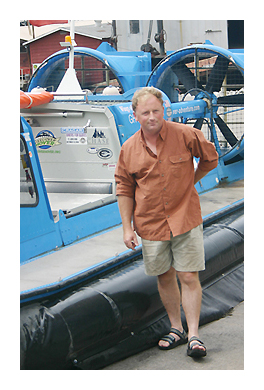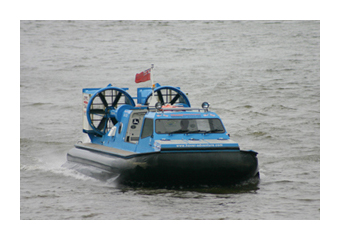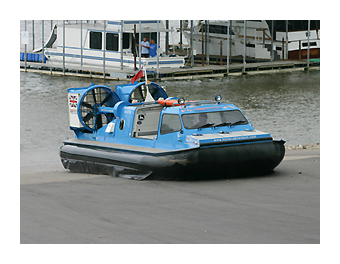English Hover Craft Adventurist Passing Through Camden
 English adventurer Robert Hodson, 39, sold his home in Godalming, Surrey, to buy a hovercraft that he's now piloting across the United States from coast to coast. His journey, skimming along 20,000 miles of river systems, is likely to be the longest hovercraft trek in history. "I grew up on National Geographic as a kid," Hodson said in explaining his thirst for adventure. "It may sound weird, but this is the natural thing to do - at least for me."
English adventurer Robert Hodson, 39, sold his home in Godalming, Surrey, to buy a hovercraft that he's now piloting across the United States from coast to coast. His journey, skimming along 20,000 miles of river systems, is likely to be the longest hovercraft trek in history. "I grew up on National Geographic as a kid," Hodson said in explaining his thirst for adventure. "It may sound weird, but this is the natural thing to do - at least for me."
A gardener by profession, Hodson was formerly an estate manager in Great Britain for the Saudi royal family. But he wanted to travel. He flew from England to Georgia so that he and the $200,000 amphibious vehicle could begin a coast-to-coast tour of the America's waterways in April.
His craft is nothing like those puny, mostly backyard-built machines that competed in the World's First Hovercraft Race on the partly-filled Lake Burley Griffin in Canberra, Australia, 40 years ago. Hodson's hovercraft, named Wings of the Dawn, is a custom Griffon 450 TD Mk II that weighs two tons and measures 11.5 by 25 feet. It uses a gallon of fuel every six miles and can travel 150 miles without refueling.
Hodson began his epic journey on April 7 on the Savannah River in Georgia and plans to cover much of the same territory originally explored by Lewis and Clark two hundred years ago. He hopes to reach the Pacific Ocean at the mouth of the Columbia River by the end of 2005. Camden, TN made it on his route map when he hovered into Birdsong Resort, Marina and Campground, September 7. Hodson's plans are to continue to the Chattanooga area for “wintering,” then resume the trek come spring.
He has weathered southern heat, storms, almost fell 90 feet off the edge of a dam and was even searched by the FBI. "I've always been fairly transient in what I do," he said. "I think for the folks that really know me, it's not such a strange thing. Federal officials searched Hodson's British boat, telling him they were looking for nitrate he could use to blow up a dam. Hodson said he only wanted to see the country the way early explorers saw it.
“I'm more interested in what lies beyond the banks of the rivers, than what meets the eye,” Hodson explained to Birdsong Resort Marketing Director Kristi Halsey. “I normally stop and stay in a location for two to three weeks, and explore the farm lands, and lifestyles.”
Always the “transient-type” he swears, Hodson hitchhiked from Key West across the United States to Alaska 20 years ago. Now age 39, he has noticed the country's hospitality and friendly conversation. "When you've got a hovercraft, it's easy to break the ice," he said. "The size of the world is in its detail. It's not the parameters.”
 Hodson bought his craft, "Wings of the Dawn," new and the hovercraft has traveled 4,000 miles without breaking down. The custom-built 2-ton craft has more than 200 square feet and uses fans to trap downward air in a skirt, lifting it above the surface. Hodson has used it to travel into areas such as swamps to see 14- to 15-foot alligators. "Duct tape and cable ties do sort of get you out of a number of problems," he snickered.
Hodson bought his craft, "Wings of the Dawn," new and the hovercraft has traveled 4,000 miles without breaking down. The custom-built 2-ton craft has more than 200 square feet and uses fans to trap downward air in a skirt, lifting it above the surface. Hodson has used it to travel into areas such as swamps to see 14- to 15-foot alligators. "Duct tape and cable ties do sort of get you out of a number of problems," he snickered.
He was enthralled by the countryside at the small-town marina located on the scenic Tennessee River's beautiful Kentucky Lake, and commented that his stay may be extended for as much as a week before continuing on eastward to Chattanooga. Robert's journals and photo gallery are online at www.hover-adventure.com, for more photos at Birdsong Resort in Camden, visit www.BirdsongResort.com.
About The Craft
The Griffon 450 TD Mk.II is an amphibious hovercraft powered by two automotive diesel engines, each driving one centrifugal lift fan and one ducted propulsion fan. The AVM engines are a 1.9litre turbo-charged and inter-cooled direct injection engine with four in-line cylinders. It produces 63kW at 3,100rpm and 215Nm of torque at 1,900rpm. Its dry weight is 150kg and it is capable of running on both conventional and bio-diesel. It is a clean efficient engine that exceeds the latest Euro III emission standards.
The craft is supported during operation on a cushion of low pressure air, contained under the craft by a open loop and segment skirt system constructed in flexible proofed fabric. The skirt allows the craft to lift approximately 0.28m clear of the ground allowing small obstacles to pass underneath with minimum drag. By containing the lift air in this way, the craft uses less power for lift, whilst the spray generated when the craft is running over water is minimized. The skirt also provides stability when the craft is hovering.
 Air for the cushion is provided by the lift fans, which are of a centrifugal type constructed in marine grade aluminum with backward facing blades. The cushion operates at a pressure of about 800 N/m2. The lift fans are located behind the cabin and are driven from the engines via poly chain toothed belts. The fans are mounted vertically in the bay. Air enters through the eye of the fans and then is ducted out either side of the hull.
Air for the cushion is provided by the lift fans, which are of a centrifugal type constructed in marine grade aluminum with backward facing blades. The cushion operates at a pressure of about 800 N/m2. The lift fans are located behind the cabin and are driven from the engines via poly chain toothed belts. The fans are mounted vertically in the bay. Air enters through the eye of the fans and then is ducted out either side of the hull.
Thrust is provided by two 1.1m diameter six bladed fans running in ducts fitted with intake grills. The blades have a running clearance in the duct of about 6mm. In the event of blade damage, they may be replaced individually without being balanced due to the uniformity of the injection molded construction.
Since the propulsion system and lift fans are both permanently driven, there is a thrust spoiling system to allow the craft to be hovered without generating much thrust. The thrust loss is achieved by moving the elevators, situated behind the propulsion fans to their extreme bow up position by pushing both foot pedals fully down. This assists in slowing down or crossing obstacles.
This article includes extracts from a story by Eric Shackle in The World's First Multi-National e-Book, http://bdb.co.za/shackle/articles/hovercraft.htm